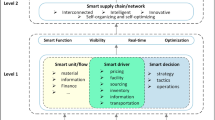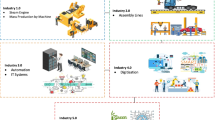Abstract
Integration of Web-Services and “smart objects” in supply chain manufacturing systems (SCM) enables enterprise innovation and competitiveness in a globalized economy. The paper proposes a web-service based architecture for SCM that enables enterprises to develop context-awareness and to achieve interoperability at data, services, processes and business levels using event based web service notifications. The architecture is analyzed and implemented following the case study of an enterprise in the automotive industry.



Similar content being viewed by others
References
Adams, N., & Want, R. (1994). Context-aware computing applications. In 1st international workshop on mobile computing systems and applications, pp. 85–90.
ATHENA Integrated Project. (2007). Advanced technologies for interoperability of heterogeneous enterprise networks and their application (FP6 IST-507849) Available on 20.12.2012 at http://archive.is/vgTG7.
Baldauf, M., Dustdar, S., & Rosenberg, F. (2007). A survey on context-aware systems. International Journal of Ad Hoc and Ubiquitous Computing, 2(4), 263–277.
Bettini, C., Brdiczka, O., Henricksen, K., Indulska, J. et al. (2008). A survey of context modelling and reasoning techniques. Preprint submitted to Elsevier.
Brown, P. J., Bovey, J. D., & Chen, X. (1997). Context-aware applications: From the laboratory to the marketplace. IEEE Personal Communications 4(5), 58–64. doi:10.1109/98.626984.
Dey, A., & Abowd, G. (1999). Towards a better understanding of context and context-awareness. In HUC ’99 Proceedings of the 1st international symposium on Handheld and Ubiquitous Computing, pp. 304–307.
EspherTech (2012). Event processing with Esper and NEesper (2012). Available on 20.12.2012 at http://esper.codehaus.org/.
Gruber, T. R. (1993). A translation approach to portable ontology specifications. Knowledge Acquisition, 5(2), 199–220.
Gu, T., Pung, H. K., & Zhang, D. Q. (2005). A service-middleware for building context-aware services. Journal of Network and Oriented Computer Applications, 28, 1–18.
Hsieh, F. S., & Lin, J. B. (2012). Context-aware workflow management for virtual enterprises based on coordination of agents. Journal of Intelligent Manufacturing. doi:10.1007/s10845-012-0688-8.
Hull, R., Neaves, P., & Bedford-Roberts, J. (1997). Towards situated computing. In 1st international symposium on wearable computers, pp. 146–153.
IBM WebSphere tutorial. (2011). IEEE standard computer dictionary: A compilation of IEEE standard computer glossaries. Available on 20.02.2012 at http://www.ibm.com/developerworks/websphere/techjournal/0811_partridge/0811_partridge.html.
INTEROP (2006). Deliverable DI.2: Enterprise interoperability-framework and knowledge corpus-advanced report, INTEROP NoE Project (FP6 IST-1-508011) JAVA. Available on (2012) at http://jcp.org/aboutJava/communityprocess/mrel/jsr224/index4.html.
Mahdavi, I., Mohebbi, S., Zandakbari, M., Cho, N., & Mahdavi-Amiri, N. (2009). Agent-based web service for the design of a dynamic coordination mechanism in supply networks. Journal of Intelligent Manufacturing, 20, 727–749. doi:10.1007/s10845-008-0173-6.
Miraoui, M., Tadj, C., & Amar, C. (2008). Architectural survey of context-aware systems in pervasive computing environement. Ubiquitous Computing and Communication Journal, 3(3), 68–76.
OASIS (2007). Available on 20.02.2012 at https://www.oasis-open.org/.
OWL(2004). Web ontology language. Available on 20.02.2012 at http://www.w3.org/2004/OWL/.
Pascoe, J. (1998). Adding generic contextual capabilities to wearable computers. In 2nd international symposium on wearable computers, pp. 92–99.
Ryan, N., Pascoe, J., & Morse, D. R. (1997). Enhanced reality fieldwork: The context-aware archaeological assistant.In Computer Applications and Quantitative Methods in Archaeology. Proceedings of the 25th Anniversary Conference, University of Birmingham, April 1997 (BAR International Series 750) (pp. 269–274). Oxford: Archaeopress.
Schilit, B., Adams, N., & Want, R. (1994). Context-aware computing applications. In WMCSA ’94 proceedings of the 1994 first workshop on mobile computing systems and applications, pp. 85–90. doi:10.1109/WMCSA.1994.16.
Schilit, B., & Theimer, M. (1994). Disseminating active map information to mobile hosts. IEEE Network, pp. 22–32.
Strang, T., & Linnhoff-Popien, C. (2004). A context modeling survey. In The first international workshop on advanced context modeling, reasoning and management, UbiComp 2004.
SupplyChainKPI (2013). Available on 20.02.2013 at http://www.klipfolio.com/resources/kpi-examples-top-inventory-metrics.
SupplyChainMetric (2013). Available on 20.02.2013 at http://www.supplychainmetric.com/.
Truong, H. L., & Dustdar, S. (2009). A survey on context-aware web service systems. International Journal of Web Information Systems, 5(1), 5–31.
Ward, A., Jones, A., & Hopper, A. (1997). A new location technique for the active office. IEEE Personal Communications, 4(5), 42–47. doi:10.1109/98.626982.
Zhou, J., Gilman, E., Palola, J., Riekki, J., Ylianttila, M., & Sun, J. (2011). Context-aware pervasive service composition and its implementation. Personal and Ubiquitous Computing, 15(3), 291–303. doi:10.1007/s00779-010-0333-5.
Zhou, J., & Shi, J. (2009). RFID localization algorithms and applications-a review. Journal of Intelligent Manufacturing, 20, 695–707. doi:10.1007/s10845-008-0158-5.
Acknowledgments
This work has been partly funded through the European Social Fund, Sectorial Operational Programme Human resources Development POSDRU 2007-2013 of the Romania Ministry of Labour, Family and Social Protection, Financial Agreement: POSDRU (107/1.5/S/76813).
Author information
Authors and Affiliations
Corresponding author
Rights and permissions
About this article
Cite this article
Danila, C., Stegaru, G., Stanescu, A.M. et al. Web-service based architecture to support SCM context-awareness and interoperability. J Intell Manuf 27, 73–82 (2016). https://doi.org/10.1007/s10845-014-0898-3
Received:
Accepted:
Published:
Issue Date:
DOI: https://doi.org/10.1007/s10845-014-0898-3




